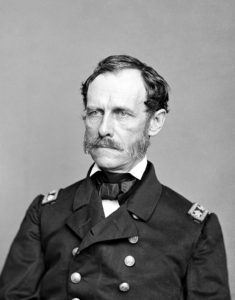 Lincoln liked John A. Dahlgren, his weapons guy, of sorts. On December 8, 1862, Lincoln sent a telegram to the Washington Navy Yard with the succinct request: “Will Capt. Dahlgren please call and see me at once?”
Lincoln liked John A. Dahlgren, his weapons guy, of sorts. On December 8, 1862, Lincoln sent a telegram to the Washington Navy Yard with the succinct request: “Will Capt. Dahlgren please call and see me at once?”
What they discussed on that particular occasion is unknown, but Lincoln often conferred with Dahlgren about the war effort. A few weeks into the war, he had pressed Dahlgren on a new gun presented by Orison Blunt. After encouraging Dahlgren to “please see Mr. Blunt,” Lincoln wrote “What do you think of it? Would the government do well to purchase some of them?” When Dahlgren replied positively the same day, Lincoln endorsed the envelope with another prod for action: “I saw the gun myself, and witnessed some experiments with it,” Lincoln wrote, adding “I really think it worthy the attention of the government.” Presumably these were the Enfield-patterned rifles Blunt made for the Army a year later.
Not long before the mysterious 1862 telegram, Lincoln had visited Dahlgren at the Navy Yard along with Secretary of State William Seward, and Secretary of Treasury Salmon P. Chase. Dahlgren took the group down to the banks of the Anacostia River to witness testing of the Hyde rocket. Instead of shooting off across the river as planned, the rocket exploded, nearly sending shrapnel into the group of distinguished leaders, all of whom escaped unharmed. Lincoln skipped the next trial two days later when the rocket flew out of control and landed on the roof of a nearby blacksmith shop.
Lincoln had also consulted with Dahlgren to discuss the veracity of claims by one of Lincoln’s old friends, Isaac Diller, who had proposed “a new and secret art of making gunpowder.” Diller was acting as an agent for a German developer of a chlorate-based gunpowder as an alternative to that based on saltpeter (potassium nitrate). Satisfied with Dahlgren’s assessment, Lincoln entered into an agreement with Diller authorizing additional secret testing in a rented building on Timber Creek in New Jersey.
Dahlgren was such an asset to Lincoln that after Lincoln signed into existence the new National Academy of Sciences, Dahlgren was assigned as one of the fifty charter members, alongside another Lincoln science advisor, Joseph Henry, Secretary of the Smithsonian Institution. It was no surprise then that Lincoln and Mary’s carriage ride on April 14, 1865, took them to the Navy Yard to talk strategy with Dahlgren, who by that time had risen to the rank of Admiral. While there, Lincoln viewed three ironclad ships recently damaged in action at Fort Fisher, North Carolina, including the Passaic-class monitor, USS Montauk. After touring the vessels and talking with Navy Yard staff, the Lincolns returned to the White House and shortly thereafter set out again for what they had hoped would be a relaxing night at the theater. Our American Cousin, a comedy, should lift their spirits as this long grueling Civil War appeared to be coming to an end.
The rest, as they say, is history.
[Adapted from Lincoln: The Fire of Genius, due out in September 2022]
David J. Kent is President of the Lincoln Group of DC and the author of Lincoln: The Man Who Saved America. His previous books include Tesla: The Wizard of Electricity and Edison: The Inventor of the Modern World and two specialty e-books: Nikola Tesla: Renewable Energy Ahead of Its Time and Abraham Lincoln and Nikola Tesla: Connected by Fate.
Check out my Goodreads author page. While you’re at it, “Like” my Facebook author page for more updates!










